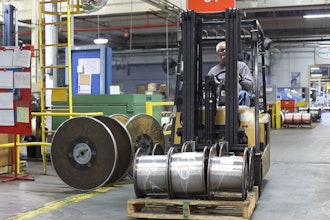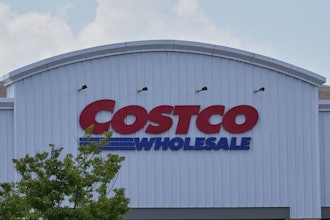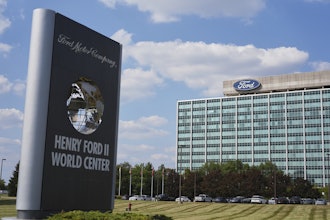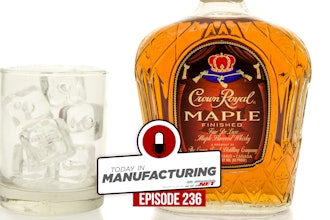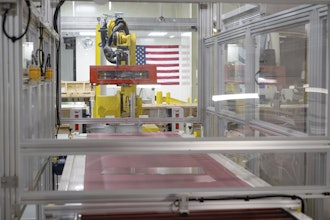One can claim that the food industry moves quickly to keep pace with changing consumer tastes and trends. Or that the industry's competitive nature brings about quick decisions in order to surpass competition. But in reality, the industry is fast-moving because it's perishable. Electronics can sit in warehouses or on shelves for months, even years - and although they run the risk of being outdated, no consumer has ever opened a television box to find it moldy, rotten or expired.
In many cases, the shelf life of food largely depends on our ability to control microbial growth. This explains why so much scientific research centers on extending the shelf life of food products by improving the ways in which we can predict and control food's microorganisms. Microorganisms in the form of yeast, molds and bacteria degrade the shelf life, quality and safety of food products.
But technologies - old and new - offer reprieve from food spoilage.
Antimicrobial sprays, washes & dips
There are a variety of specialty chemical companies producing antimicrobial solutions for the food industry. The technology behind these solutions has its roots in basic chemistry. Bacteria's ability to survive in extreme pH's depends on its ability to correct for outside changes in order to maintain the proper pH inside the cell. Thus, by creating a low pH - acidic - environment, bacteria on food become uncomfortable and begin to seek out what they need to survive, depleting a significant amount of their energy and eventually leading to their death.
Applications
Most commonly used with poultry, seafood and produce, the products are versatile because they can be applied in various ways and forms throughout a plant - and in fact are more effective when used in multiple stages of food processing. Antimicrobial solutions can be added to chill tank, scalder or wash water. The solutions can be sprayed directly on to product surfaces at different points as they move down the line.
Safety
The sprays, washes and dips are non-oxidizing, meaning they can be used in water-based environments, where there is a significant amount of suspended or dissolved organic matter, without effectiveness being impaired. Reputable companies offer solutions with components that are Generally Recognized As Safe (GRAS) by the FDA. The GRAS status allows for the direct use of the products on food without rinsing or additional product labeling. It varies by company, but the potential for organic status also exists.
The solutions do not produce oxidized compounds - so there will be no off-odors or flavors to treated products. In addition, there are no toxic by-products left behind in the air that could prove harmful to employees.
A different approach
One manufacturer, Tasker Products Corp. (Fair Lawn, NJ), offers antimicrobial products with a twist. In addition to the acidic mixture found in most solutions, Tasker's patented process adds a copper sulfate complex to the solution.
Dan Neely, Director of Business Development for Tasker, explains the process: "When put in a low pH environment, the bacteria begin to scavenge for sulfates. The copper attaches itself to the sulfates and thus gains entrance into the cell. Copper - toxic to single cell organisms - begins to destabilize proteins and destroy their structural activities, leading to the inhibition of cellular processes."
The two-pronged antimicrobial action offers an effective, safe approach to eliminating dangerous pathogens like E. coli and salmonella, as well as killing yeasts and molds.
Shelf life stats
Unfortunately, there is no one answer when it comes to how much time antimicrobial sprays and washes can buy you. Shelf life increase varies according to the initial bacteria count of the product, the type of product and the length of time the antimicrobial was applied. On average, however, look to see a 3-4 day increase in shelf life.
Silver-based antimicrobials
It is claimed that the use of silver as an antimicrobial can be traced all the way back to ancient Greek medicine. Silver ions, released over time, disrupt microbe growth by inhibiting cell respiration and reproduction, as well as disrupting cell metabolism (the cell's processing of nutrients). Many intelligent silver-based antimicrobials are structured to facilitate the gradual release of silver ions, as necessary to control bacterial growth.
Applications
Silver-based antimicrobials have a variety of uses in the food industry that span beyond just increasing shelf life. Unlike other antimicrobials on the market, silver is thermally stable - meaning it does not degrade at elevated temperatures, thus broadening its scope of useful applications. There is a growing interest in the industry in using silver antimicrobials in coatings on equipment or embedded within solid surfaces. Typically, this is an epoxy coating with the silver antimicrobial added. Companies offer the coating as an optional feature on their products - for example, you can buy a conveyor belt with a silver-based antimicrobial added at the time of manufacture. Silver can also be incorporated into packaging or even employee uniforms. When added to disinfectant sprays, silver is still effective, but the antimicrobial protection is not as long-lasting as it would be in a more permanent surface coating.
A different approach
One silver-based product that might soon be seeing some playing time on the processing floor of the food industry is an antimicrobial liner called FoodTouch®, a patent pending paper component product manufactured by MicrobeGuard®. Already celebrated by top chefs around the world for its ability to extend the shelf life of fresh steaks, fish and pork, the liner combines a silver zeolite component (manufactured by Agion™) with a deep textured design that creates surface air pockets. It has seen considerable success in seafood applications, where fish wrapped in the FoodTouch paper exhibited enriched color, reduced odor and better textural integrity. The neat part about the liner is that in addition to its antimicrobial properties, it can be custom-made in specific colors for different food types, like black for red meat or green for Tuna or custom printed boasting specific brand names.
Safety
Silver is EPA, FDA and USDA-approved for use in food processing, when proper levels are maintained and guidelines are followed. Agion, one of the larger providers of antimicrobial solutions based on silver, touts it as "nature's antimicrobial."
Most antimicrobial products on the market contain less silver than one would consume by drinking a glass of tap water. Silver ions are odorless, colorless and tasteless, so food products won't be changed.
Ozone
The usefulness of ozone as a sanitizer has been known for quite some time - however, commercial success of the naturally occurring molecule has been somewhat hindered by misconceptions and past mistakes. Like other shelf life solutions, ozone's effectiveness is rooted in basic chemistry. Ozone (03) is a highly reactive form of oxygen. The molecule is considered unstable because the third oxygen atom is very loosely bound to the other two oxygen atoms. The unstable oxygen atom (the molecule's third wheel) cannot stabilize until it finds something to combine with and form a stable molecule. Bacteria on the surface of food, for example, absorb these O3 molecules which, due to their instability, very quickly break apart - thus literally exploding the bacteria.
Applications
Ozone is commonly used in an aqueous solution in place of chlorine. Ozonated water can be used in wash water or spray washing systems, and has been proven especially effective on fruits and vegetables. It can also be used to sanitize equipment and food contact surfaces. In a gaseous phase, ozone can be used in food storage areas to control mold, mildew and bacteria in the air and on products.
Eric Critchlow, VP of Sales at Ozone International, describes the ideal application of ozone: "In an ideal world, the ozone product would be utilized throughout the entire supply chain. In the fishing industry, for example, the vessel would use ozone to clean and sanitize the hold, as well as using ozonated ice. This way, the fish enter a sterilized environment. The fish would then be ozonated as they come in the door of the primary processing plant and again hit with ozone during various processing stages, removing external and internal bacteria. The distributor and retailer would also use ozone to clean surfaces that the fish come in contact with as well as the product itself."
"If we ozonate from beginning to end, we might end up with a totally different product - one with a shelf life previously unheard of in the food industry."
Ozone International has taken a unique approach to ozone cleaning by utilizing a high-pressure water stream alongside the traditional low-pressure ozone-infused water stream. This system, known as WhiteWater, allows for continuous cleaning and sanitizing during production, thus eliminating the downtime associated with stopping to clean equipment. The dual system allows for the destruction of bacteria and biofilms, while keeping the ozone levels low.
Benefits
Ozone is listed on the National Organic Program's "National List of Allowed and Prohibited Substances" as a non-agricultural substance that may be used as an ingredient in or on processed products labeled as "organic" or "made with organic." In addition, there is no special labeling required to indicate that products have been ozone-treated.
Ozone, unlike other disinfectants, does not form any toxic by-products when it reacts with organic matter, and kills bacteria 3100 times faster than chlorine.
Safety
Using ozone requires training, although companies offering ozone-related products should provide this training and most promise it is relatively uncomplicated, and in some cases, poses less risk than cleaning and sanitizing with conventional chemicals. Ozone must be generated onsite, which can be considered both a positive and negative. Proponents claim that onsite generation is safer, as it eliminates the transporting, storing and handling of hazardous materials.
In 2001, the FDA ruled that ozone may be safely used as an antimicrobial agent in the treatment, storage and processing of foods, including meat and poultry.
OSHA and EPA have maximum acceptable gaseous concentration levels for ozone which must be adhered to. Initial signs of overexposure to ozone in humans are usually limited to skin rashes and lung irritations. Most products on the market have built-in ozone monitors and applicable safety systems to insure that ozone levels stay under the limit, and some even offer remote monitoring options.
Natural Polymers
Preservatives are often added into food products, just like ingredients. As the product sits on the grocery store shelf, the preservative (in this case, antimicrobial) begins to decrease in concentration as it interacts with the food matter. Once the concentration hits a level that is not harmful for the microorganisms, they can prosper - and food begins to spoil.
Dr. Michael L. Chikindas, an Associate Professor of Microbiology/Molecular Biology at the Rutgers University Department of Food Science, explains the necessary solution this way: "Imagine a shop keeper walking past the shelves of food and injecting additional amounts of antimicrobial with a syringe into the packaging - this is unrealistic, but basically exactly what is needed." Increasing shelf life requires maintaining the exact concentration of antimicrobial in the system for as long as possible.
It was this need, coupled with the food industry consumer's desire to purchase food with less chemical additives, that inspired a team of chemists and microbiologists at Rutgers to explore natural derived polymers. The polymers of natural derived substances - those produced by plants - are substances that we consume often, and are therefore documented as being safe to use. Chemists sought to employ these antimicrobial substances in sophisticated, intelligently-designed packaging material. The packaging material would release the polymers over time and help maintain the desired antimicrobial concentration.
Antimicrobial substances (scientifically, "the monomers") embedded in the packaging are not active when polymerized, and thus, can be formulated to release from the packaging material under certain pre-determined conditions. The condition of release is coded in the linkers that are connecting these monomers to each other. So for instance, linkers can be coded so that the monomers are released upon a change in pH, temperature or appearance of certain enzymes in the environment.
Blocking biofilms
An important function of these natural polymers would be blocking the formation of bacterial biofilms on the surface of foods and packaging. Biofilms are layers of bacteria that can attach to surfaces as well as to each other. When formed on equipment surfaces, these films are tough, slime-like and resistant to most conventional washing and sanitizing practices. When formed on food surfaces, they cause food spoilage.
When a biofilm is formed, the bacterial cells become trapped, but at the same time are protected from environmental stresses. Biofilm-associated bacteria are much more resistant to stresses, as opposed to free cells. Food spoilage bacteria form biofilms, thus expediting the spoilage process. Scientists at Rutgers are performing studies in order to fully understand how these monomers can influence the formation of biofilms. The primary goal is not to kill the pathogens on the food, but to prevent the biofilm formation altogether.
Preventing the formation of biofilms keeps undesirable bacteria vulnerable to all kinds of antimicrobials. Furthermore, attacking the biofilm, rather than specific bacteria, will decrease the chance of developing antimicrobial resistance. This is good news for consumers ingesting the polymers, as the over-prescribing of certain antibiotics has made antimicrobial resistance a growing a problem in the pharmaceutical world.
Antimicrobial packaging
The concept of intelligent-antimicrobial packaging has been around for over 20 years, and is not unique to Rutgers University. In fact, antimicrobial packaging is a common discussion when it comes to preserving shelf life in the food industry, and is an umbrella term that involves numerous packaging techniques used to control microbial growth. Most initiatives seek to modify the packaging material in such a way that it entraps the substance that they want to deliver.
Examples include coating the contact surface with a particular polymer that will have the antimicrobial embedded, or manufacturing the packaging material in such a way that a pocket is produced for accommodating the antimicrobial release.
A different approach
Rutgers scientists are searching for a more efficient approach by working with the polymers of the food product's active monomers, instead of trying to incorporate additional monomers into the packaging/food surface. By polymerizing the food's active monomers, scientists make them inactive - and they are then unable to form biofilms.
Chikindas explains, "The uniqueness of our approach is in making polymer that consists of the monomers of biologically-active substance(s). Based on the selection of specific linkers (these connect the monomers), the conditions of release can be engineered." This approach was pioneered by the Rutgers Chemistry Professor Kathryn Uhrich who is leading the Rutgers' project.
What this means for food processors
This approach is not limited to packaging material. The created polymers can be shaped and formatted into food products as well. Therefore, the approach is not limited to surface delivery and can be safely used for delivery into the food product itself. The ultimate goal would be to develop a system that can be used in large scale manufacturing.
These created polymers can be formulated, stored and kept for an extended period of time, and they wouldn't start working until they came in contact with food. So the coated packaging, for example, wouldn't lose effectiveness while being stored in anticipation of use. However, the specific selection of natural microbials will prove important, as avoiding ones with smells or flavors that could affect the product itself will need to be avoided. Natural antimicrobial agents derived from cloves, oregano, thyme and paprika are currently being tested.
Conclusion
To date, there is no single panacea for shelf life extension. Using a combination of available options at various stages of production has proven effective, yielding an average shelf life extension of three to seven days. Increasing shelf life is a multiple value proposition. Products that last longer don't have to be shipped as frequently as those with very short shelf lives, and thus, fuel and shipping costs are lessened. Not only will everyone along the food chain line face less loss due to product spoilage, but products will look and taste better longer and even offer less chance of food-borne illness.
or more shelf life extension methods, see the article on irradiation on page 18. Lactobacillus sake








